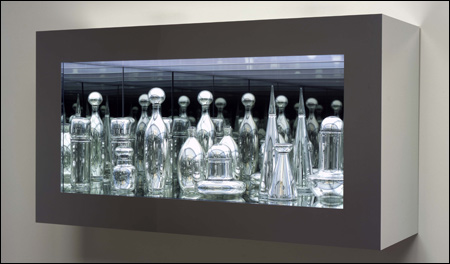Oskar Kokoschka is reputed to have asked, if the Louvre were burning and you could rescue either the Mona Lisa or a cat, which would it be? He wasn’t being silly. The question comes down to the fundamental importance of life itself — whether anything that breathes shouldn’t be valued above everything that doesn’t.

JOSIAH MCELHENY’S CZECH MODERNISM MIRRORED AND REFLECTED INFINITELY: A wonder even if it doesn’t get far beyond being a magnificent department-store display case. |
I was reminded of Kokoschka’s challenge by the dazzling, and in a curious way humble, space that the ICA now enjoys in its extreme makeover in Fort Point Channel: no matter what sculpture, video, installation, painting, or sculpture you’re looking at, you’re never more than a few feet away from a spectacular panorama of ocean and sky. The glass-sided building beckons you to engage with the wide-open world of possibilities with the same energy and attention with which it invites you to take in the products of human imagination. The architects appear to be reminding artists and audiences alike that the temple to which art belongs has no ceiling, isn’t static or windowless or an isolated retreat but a bright and vibrant and surprising place poised between land and sea.
Only someone who would grab the cat can fully appreciate Leonardo, and only architects who appreciate the necessary limits of art could have created such a superb display case for it. There are five shows currently on exhibit: the intelligent if somewhat predictable “Super Vision”; the permanent collection on view for the first time; the four local finalists for this year’s James and Audrey Foster Prize (formerly the ICA Artist Prize); the latest in the ICA’s “Momentum Series”; and of course the building itself courtesy of Diller Scofidio + Renfro.
Op art and surveillance videos, strobe photography and mirrored vessels, stainless-steel rabbits and laminated-wood sculptures are among the items served up in “Super Vision,” a loosely conceived, eclectic smorgasbord of mostly playful, occasionally provocative, and uniformly accomplished pieces that in various ways riff on the possibilities and improbabilities of seeing. The show serves up a 40-year overview of the intersection of technology and art. At one end live the advances in still photography achieved in the 1960s, notably Harold Edgerton’s experiments in strobe photography at MIT. In his eternally combustible 1964 Shooting the Apple, a bullet suspends in mid air, caught in its exit from the McIntosh. Behind it you can see two luminous, lace-like explosions where it has entered and departed the skin: speed and violence rendered as stillness, an instrument of death partying with an emblem of wholesomeness. What could be more American? Four years after Edgerton’s fast applesauce, the astronauts aboard the Apollo 8 took the first deep-space picture of planet earth, an apple-sized orb bobbing in blackness whose delicate swirls of white clouds over blue oceans remain a reminder, more Christmas ornament than paperweight, of our fragile globe.